Abstract
Wildlife control in and around commercial airports is a major concern for civil aviation management authorities in the United States and various parts of the world. In this paper, the focus was to evaluate the magnitude of the problem and ways in which various airports are managing it. The goal was to find better ways of addressing the problem than what is currently in use. The study shows that terrestrial mammal incursion on the runways is a more dangerous threat to aircraft than bird-strike, but it is less likely occurrence. Many airports have developed security mechanisms to eliminate large objects on runways that may cause accidents. However, bird-strike is still a major concern. It is not easy to predict behavioral patterns of the bird or manage their movements. Some of them fly at planes cruise altitude, a fact that makes them dangerous even when an aircraft has safely taken off from airports. The study suggests structural changes on the design of some sensitive parts of the plane such as engines and windshield to make such impact less dangerous. The cabin crew, traffic controllers, security officers, and other relevant stakeholders should also be taken through regular training to learn how to deal with wildlife incursion using modern technologies.
Introduction
Managing the safety of the airports is one of the most important responsibilities of civil aviation authorities around the world. According to Stolzer and Goglia (2016), issues such as terrorism, criminal activities, and animal incursions pose serious threat to aviation security. The threat posed by wild animals has forced many airport authorities to find effective ways of dealing with the problem. Proper fencing has made it possible to keep off animals such as wild dogs, jackals, and other mammals from the runways. However, dealing with birds in the air has remained to be one of the major challenges in the aviation sector.
Desoky (2014) explains that it is not possible to predict the pattern of behavior of some birds. Given that they are airborne, it is not possible to control birds using physical barriers such as fences. Numerous cases of bird strikes during landings and takeoffs have been reported in this century for decades. Some of these strikes ended in fatalities. Other than the loss of life, such intrusions often cause major financial consequences, especially in cases of plane crash. Desoky (2014) report that animal incursion still remain to be a major problem in many airports in the United States and around the world. In this paper, the researcher will focus on evaluating wildlife controls in and around commercial airports.
Justification of the Study
Security in the aviation sector is the factors often given priority because of the magnitude of the consequences of accidents and incidents. An Airbus A380 can carry over 850 passengers. The plane costs US$375.3 million. When it is involved in a major crash, it can lead to loss of many lives. The company may also find it difficult to recover from the loss of such an expensive asset. A significant number of these accidents are often caused by wildlife incursion into the airports and the surrounding environments. Scheideman et al. (2017) say that “wildlife incidents with aircraft cost airports and operators worldwide an average of US $1.28 billion annually” (p. 408). The massive costs of associated with the problem it necessary to find a lasting solution. The paper focuses on finding ways of addressing the problem. As Desoky (2014) observes, addressing the threat posed by birds may not be easy. Leading airports around the world may not fully control the behavior of birds even when some of the latest technologies are used. One cannot know when a large bird will cross paths with a commercial plane when landing or taking off. However, various measures can be taken to deal with the problem. The paper will provide a guide to stakeholders in the aviation sector on how to deal with the problem.
Analysis and Discussion
Animal incursion at airports and surrounding environments has been a major concern in the aviation sector for decades, as Desoky (2014) observes. Mammals such as dogs, jackals, and even large domestic animals sometimes find their way into the runways, posing serious threats to aircrafts which are landing or taking off. Many large commercial airports have been able to address this problem by having proper fences that can keep off animals. However, dealing with the problem of birds in the surrounding environments is still a major issue. Desoky (2014) provides a historical account of some of the major incidences of bird strikes at various airports around the world. On April 13, 1912, a small aircraft collided with a bird at Long Beach, leading to the death of the pilot. On October 4, 1960, a bird strike on Eastern Air Lines Flight 375 led to engine failure. The plane crashed, killing 62 of the 72 people on board. On September 15, 1988, the engines of Ethiopian Airlines Flight 604 sucked a flock of pigeons, and crash-landed, killing 35 of the 104 people on board.
On April 29, 2007, Thomsonfly Boeing 757 suffered an engine failure after ingesting a heron bird soon after taking off at Manchester Airport (Kazda & Caves, 2015). The engine caught fire, but the crew were able to land safely back at the airport without any casualty. On April 1, 2016, Ryanair Flight FR3445 was forced to make an emergency landing at Manchester Airport soon after takeoff because its engines sucked a bird (Desoky, 2014). These cases demonstrate dangers of bird strike in the aviation sector. It also shows that proper measures are yet to be put in place to help deal with this problem. It is necessary to look at the statistical figures that demonstrate the magnitude of this problem.
Statistical Analysis of the Challenges Posed by Wildlife
According to Atwell, Hilterbrand, Kaffka, Lauber, and Shore (2015), every airport has a responsibility to ensure that there is safety of passengers, aircraft, and other relevant facilities. Most of the air accidents often lead to fatalities and massive destruction. As such, the civil aviation society often considers safety and security of passengers and aircrafts top priority. One of the factors that compromise aviation security is collision with wildlife. Terrestrial mammals and birds pose the greatest threat to the aircrafts. Based on data collected from various sources, the researcher compared aircrafts struck by wildlife in the United States from 1990 to 2014. Figure 1 below shows the findings.
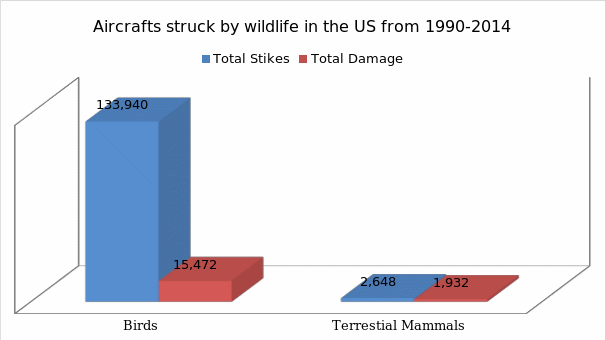
As shown in the figure above, over 133,940 aircrafts were struck by birds between 1990 and 2014. Most of these strikes take place during takeoffs and when the planes are landing. Some of them occur at the cruising altitude, especially among the small crafts. Birds were responsible for significant damage of various parts of 15,472 planes. Within the same period, 2,648 planes collided with terrestrial mammals. The collision takes place during landing and takeoff processes. They led to damage of 1,932 aircrafts. The statistics show that birds pose a greater danger to the aviation safety. Although collision with terrestrial mammals is a more dangerous encounter, it is a rare occurrence compared with bird strikes. The introduction of effective fences has also helped address the problem. However, it is still a challenge dealing with the threat posed by birds. Figure 2 below shows the increasing cases of bird strikes from 2009 to 2014.
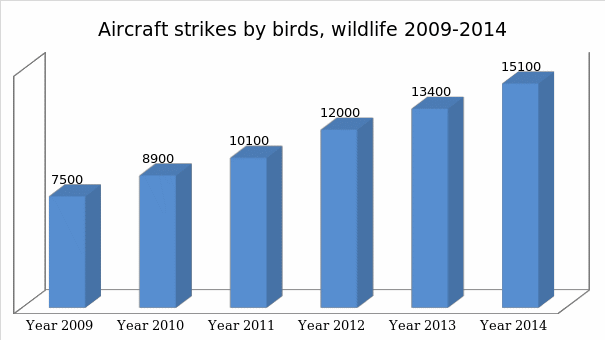
As shown in the figure above, there has been a consistent increase in the number of bird strikes from 2009 to 2014. In 2009, 7,500 bird strikes were reported by the country’s aviation sector. It increased to 8,900, 10,100, and 12,000 in the three subsequent years. The number of bird strikes in 2014 was more than twice what it was in 2009. Desoky (2014) explains that the increasing number of bird strikes may be caused by the high number of planes taking to the skies. However, it is an indication that something needs to be done to address the problem as soon as possible. The more the cases of airstrike continue to be witnessed, the more lives of those who use the aircraft are put at risk. Figure 3 below an aircraft’s collision with a bird. Such collisions can be dangerous, especially if a large bird is sucked into an engine, causing a failure.
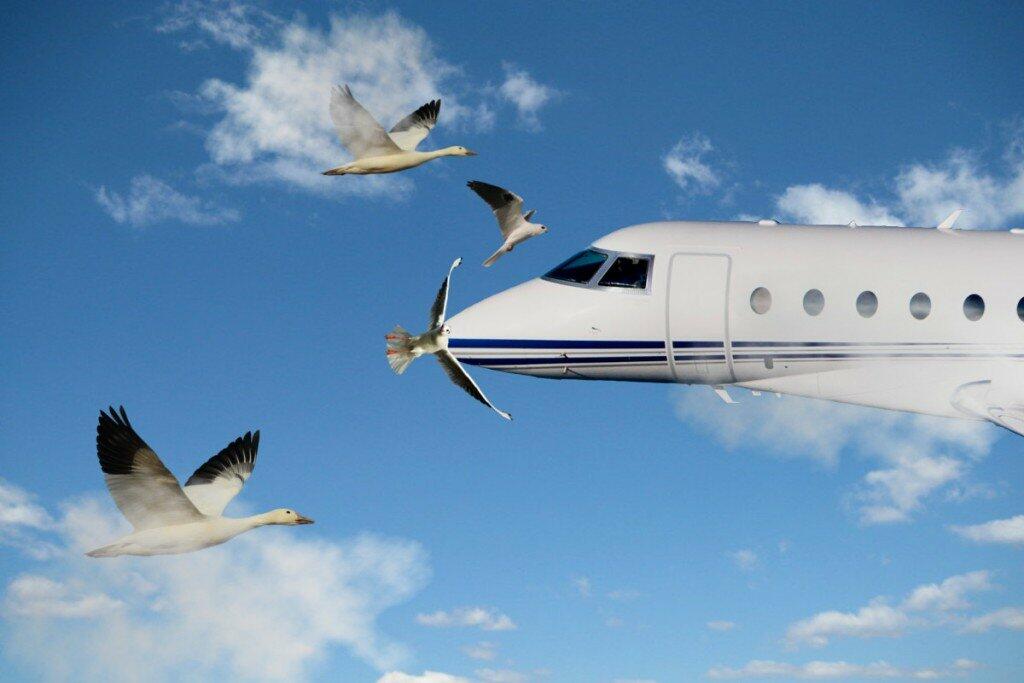
Relevant Training to Improve Efficiency and Safety in the Airports
According to Stolzer and Goglia (2016), pilots, crew members, traffic controllers, and emergency management team within various airports need to go through proper training on how to deal with the problem of wildlife incursion. On January 15, 2009, US Airways Flight 1549 left LaGuardia Airport in New York for Tacoma International Airport, Seattle. However, the plane struck a flock of geese and lost all engine power (Stolzer & Goglia. 2016). It was impossible to steer the plane back to the airport because of the distance involved. The pilot made a quick decision to safely ditch the plane into the nearby Hudson River, off Midtown Manhattan (Stolzer & Goglia. 2016). It was the first time such a large passenger plane was landed in a large water body.
Fortunately, all the 155 people on board the plane were rescued with no major injuries (Kazda & Caves, 2015). Figure 4 below shows passengers being rescued from the plane after it landed in the river. Many aviation experts had never thought that would be a possible occurrence. However, the expertise of the pilot and the crew members showed that with proper training and necessary skills, it is possible to save hundreds of lives of passengers even when faced with such a serious threat. It makes it necessary to find ways to have proper training for various officers responsible for the management of the aircraft and airport.
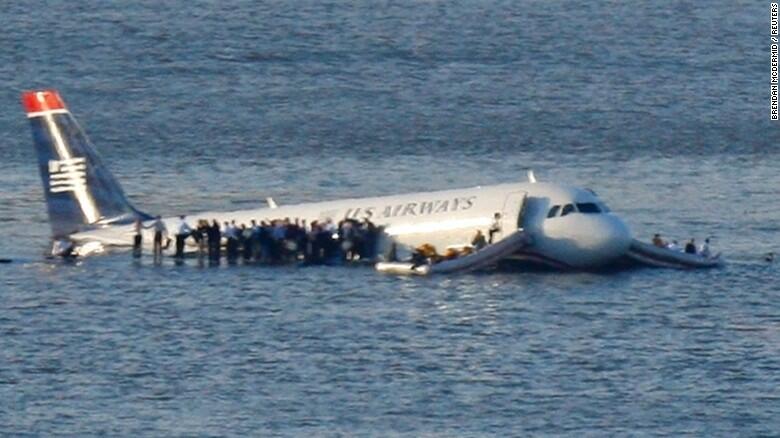
Pilots and crew members should be trained on how to deal with serious emergencies in cases where systems fail in the plane because of engine failure after striking a bad. The US Airways Flight 1549 landed in the river without any fatalities because of the unique skills of the crew members. New course should be introduced that will equip pilots with skills needed to overcome such extreme challenges. Advanced airport operation is an important course that offers a wide range of concepts needed by employees assigned different roles in the normal management of airports.
Safety management system for airport is one of the concepts which are relevant to airport employees, especially the emergency and rescue team and traffic controllers. It equips them with knowledge on how to deal with serious emergences such as cases where an aircraft has to make an emergency landing when in distress. Collaborative airport decision making is another important concept in this course that makes it possible to enhance security in the airports. When there is an emergency, different stakeholders can work as a unit to ensure that a plane lands safely. IATA has also introduced short courses for pilots, cabin crew members, traffic controllers, and other officers within an airport. Risk management implementation is a five-day course meant to equip cabin crew members with skills that can enable them deal effectively with emergencies. As Desoky (2014) suggests, trainings should evolve based on the changing technologies and threats that the sector is facing.
Radar Tracking Systems
Technology has become the prime solution to most of the challenges in the aviation sector. According to DeVault, Blackwell, and Belant (2013), Radar is one of the best solutions that have been developed to solve the problem of birds and other airborne objects that pose serious threats if they collide with planes. Radio detection and ranging (Radar) is defined by Stolzer and Goglia (2016) as “an electronic detector system that measures distance or velocity by sending a signal out and receiving its return” (p. 45). As explained above, airports have been unable to control the movement of birds in paths frequented by planes. Some of the migrating birds can cross such paths at any time. Desoky (2014) explains that many airports in the United States have reported cases of bird incursion at times when least expected. Birds such as Ruppell’s griffon vulture can fly at cruising altitude of commercial airplane, making them dangerous even when planes are away from airports. The emergence of this radar was meant to help address the problem of mid-air collision between airplanes and various objects on their path.
The detector can pierce through darkness and thick fog into the horizon. It shows landmass, clouds, and any other object that is on a plane’s path and its surrounding environment. It is designed to measure distance between the aircraft and the object and its position along the path that should be taken. When the detected object is on motion, the system can enable the pilot to understand the direction, speed, and altitude so that an appropriate decision can be made (Kazda & Caves, 2015). Some of the highest flying birds such as Ruppell’s griffon vulture and bar-headed goose are considerably large and when they collide with a plane, they may cause significant damage on the point of contact. A pilot can make a quick decision to lower or increase the cruise altitude or slightly change the direction to pass such an object before it can cause a serious damage to the plane. Most of the planes fitted with the system no longer have to worry about bird attack. However, Desoky (2014) warns that having the system is not a silver bullet that solves all problems related to bird strikes. It only makes it easy for pilots to see the birds while they are miles away so that the right decision can be made to deal with the problem. The pilot and first officer still have a responsibility of making the right decision on how to maneuver the aircraft away from potential threat.
Safety Programs, Control Measures, and Procedures
Pilots, cabin crew members, air traffic controllers, emergency management officers, and various other stakeholders go through rigorous training to ensure that accidents and incidents are eliminated. According to Desoky (2014), besides the standard training relevant to each officer based on the area of specialization, safety and security management are common courses that all the officers have to learn to respond to cases of emergency when they arise. Emerging threats and changes in the aviation sector defines the nature of course needed for these officers. The skills needed by the pilots and the cabin crew when in the airplane are different from that needed by the ground officers. It is necessary to look at the safety programs, control measures, and procedures needed by different officers in managing wildlife in airports.
Pilots and cabin crew
According to Kazda and Caves (2015), pilots and cabin crew may not have a major role to play in controlling wildlife within airports that they use. However, they have a responsibility to report their encounters so that control measures can be taken. As a standard procedure, pilots are expected to make reports about challenges they encounter with planes and airports. It is their responsibility to report when the presence of birds and other wild animals that they spot within the airports and surrounding environment even if they did not pose any significant threats to their flight. Desoky (2014) warns that assuming the airport management is aware of the presence of such wildlife can be dangerous. In some cases they may not be aware. Even if they know about these animals, making official reports puts pressure on the management to act on the issue so that it does not degenerate into a disaster.
A new standard procedure should be introduced to allow pilots to make such formal reports because it can help in preventing serious accidents within various airports around the world. In cases where the engine gets damaged after ingesting large birds, pilots should know what to do to save lives of passengers. Kazda and Caves (2015) argue that extreme pilot training may be necessary to make it possible to guide planes to safety even when all the power in the engines is lost. They should learn not to panic in such dangerous encounters to help ensure that they remain in control of their aircraft.
Air traffic controllers, emergency management team, and other ground officers
The ground officers have a major responsibility in controlling wildlife away from airports. According to Desoky (2014), security officers have to ensure that no wild terrestrial mammal has access to the airports, especially the runways. It is a standard practice for major commercial airports to have perimeter ways and other security fences to limit entry and exit into the airport. However, one of the control measures for the officers is to make regular rounds just to ensure that there is no breach in the fences. In case there is a breach, an immediate action must be taken to ensure that wildlife does not pose a threat to the planes landing and taking off. Some passengers often travel with pets such as dogs when they get permitted by the airline and relevant airports. The security officers should ensure that in case such animals escape from their owners, they are not let to wonder within the airports. Security officers may sometimes be required to destroy birds’ nests in the environment surrounding the airport as a means of driving them to other safer locations.
Officers responsible for cleaning the runways have a major role to play in fighting the problem having dangerous objects on the runways. Other than doing the normal cleaning of the runways, they have to ensure that any terrestrial mammals are eliminated from the airport, especially along the runways. When they notice presence of a bird or a flock of birds that was not there before, they need to make reports to relevant authorities so that appropriate actions can be taken. The air traffic controllers should work closely with other ground officers and the pilots to ensure that any form of threat is eliminated at a time when planes are taking off or landing at the airport. Kazda and Caves (2015) note that safety programs require air traffic controllers to warn pilots against landing or taking off when birds are flying dangerously within the airport. The emergency management team on the other hand should be ready to deal with incidences and accidents that happen because of animal incursion within the airports. Control measures are put in place to eliminate accidents. However, it does not mean incidents may not arise within the airport. Having a fully equipped and well-trained team of emergency management officers may help rescue passengers within the airport when an issue arises.
Structural Factors of Improving Safety
According to Desoky (2014), most of the bird-strikes often cause minimal damage and a pilot is able to land the plane safely without any emergency. However, some strikes may cause a major concern, as discussed above, especially when a large bird is sucked into the engine, causing a failure. As such, designers of modern planes are coming up with ways of making bird-strikes to be safe occurrences when the plane is off the ground. Identifying sensitive parts where such strikes occur is the first step in solving the problem from a structural perspective. Figure 5 below identifies parts of a plane which are often struck by birds. Each of these parts may need different structural design approaches to protect them from such incidences, as discussed below.
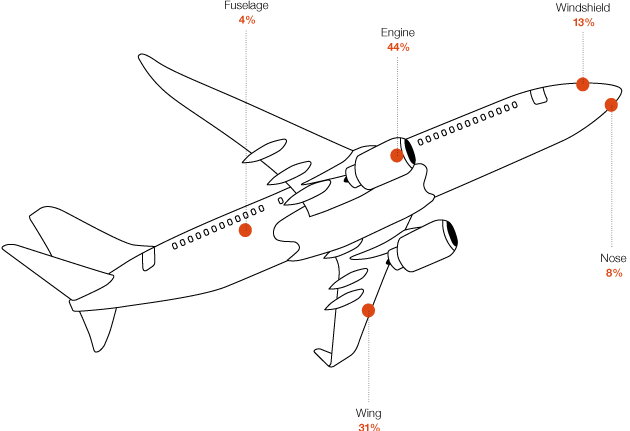
Engine
As shown in figure 5 above, the engine is the worst affected part of a plane with the problem of bird-strikes. It accounts for 44% of all strikes because of the size, location, and its suction effect. It is also one of the most sensitive parts of the plane to such strikes. If a large bird is sucked into the engine, it may result into a failure. As such, designers are coming up with new ways of protecting it. As shown in figure 6 below, a simple step of introducing turbojet engine protection grill can help in addressing the problem. This physical barrier is meant to prevent cases where large objects are sucked into the engine. It is designed in a way that makes it possible for the engine to have access to air as much as possible while at the same time remain protected from foreign objects. The functionality of the engine is not impaired in the process.
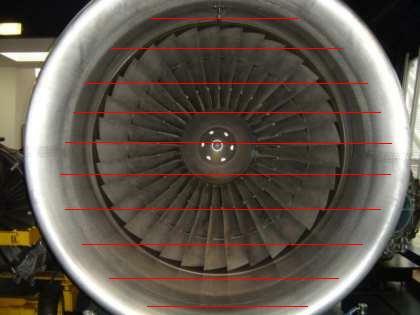
Windshield
As shown in figure 5 above, 13% of bird-strikes hit the windshield. Most of the commercial jets have strong windscreen that can withstand such an impact without any significant damage. According to Kazda and Caves (2015), light aircrafts have windshield that can withstand an impact of 1.8 kilograms while large commercial jets can withstand an impact of 3.6 kilograms. Incidents where an aircraft’s ability to land safely is affected by such bird-strikes are very rare (Scheideman et al., 2017). However, such occurrences often cause a scare among cabin crew and passengers, especially when the windshield is crashed because of the magnitude of the impact. On November 22, 2012, a Cape Air flight Cessna 402C was struck by a bird minutes after taking off from Barnstable Municipal Airport in Massachusetts (Sheridan et al., 2015). The pilots were forced to make emergency landing soon after the strike. The co-pilot was scratched by shards of glass, but no major injuries were reported because the pilots were able to land the aircraft safely after the strike. Figure 7 below shows the aftermath of the strike. Desoky (2014) believes that the solution to such strikes is to strengthen the windshield so that it can withstand greater force.
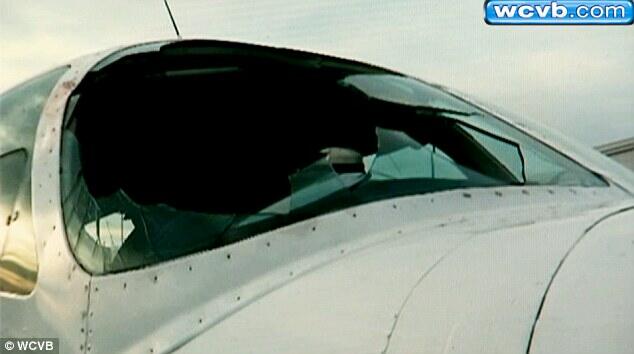
Nose, wing, and fuselage
Figure 5 above shows that the nose and wings are often receive significant hit by bird strikes, at 8% and 31% respectively. However, most of such strikes do not have major impact on the ability of the lane to land safely. Kazda and Caves (2015) believe that these parts should be strengthened to have greater capacity to withstand such impacts. The fuselage, which is the largest part of an aircraft, is rarely hit by birds because of the location. Only 4% of such strikes affect the fuselage. The impact of such strikes is often negligible and as such, it may not need major structural redesigning purposefully to address the problem of bird-strikes. However, it should be strong enough to withstand major impact when making emergency landing in extreme conditions. It should remain in one piece to enhance chances of survival of passengers.
Legal and Regulatory Factors
According to Graham, Papatheodorou, Forsyth (2016), sometimes it may be necessary to use legal and regulatory means to enhance safety of passengers, crew members, aircraft, and airport facilities. A significant number of accidents that happen in the aviation sector are caused by acts of negligence and lack of responsibility. It may be necessary to make everyone feel that they are responsible, both criminally and otherwise, of accidents that happen because of acts of negligence. Security officers have the responsibility of ensuring that perimeter walls and other fences are not breached by terrestrial mammals that pose great danger to airplanes when taking off or landing. When such errors occur, the management of the airport should be held responsible, especially if the report had been made and no action was taken. In case it is established that specific officers failed on their duties, Desoky (2014) suggests that dismissal should not only be the punitive measure, particularly if the act of negligence led to an accident or a major incident within the port. Having such strict regulatory policies minimizes cases of negligence when controlling wildlife incursion at airports.
Conclusion and Recommendations
Wildlife incursion poses serious threat to planes during takeoffs and when landing. High-flying birds may strike a plane’s engine even when it is at a cruising stage. The historic landing of US Airways Flight 1549 on Hudson River is a reminder of the danger that bird pose to planes. As such, stakeholders have come up with different ways of dealing with the problem. It is critical to improve security at airports to avoid incursion of wildlife, especially on the runways. Some scholars have suggested that it may be necessary to improve designs of the aircrafts to enhance their ability to withstand bird strikes. Using regulatory policies may eliminate acts of negligence at airports. The following recommendations should be taken into consideration:
- Airports should use new technologies to monitor movement of any unauthorized animals or persons within the airport, especially on the runways.
- Improving structural designs of the planes can make them capable of withstanding bird-strikes.
- Cabin crew, traffic controllers, security officers, the emergency management team, and other relevant officers should go through regular training to learn how to deal with crisis such.
- Having strict legal policies can also make all the stakeholders feel responsible for enhancing airport security.
References
Atwell, N., Hilterbrand, J., Kaffka, C., Lauber, A., & Shore, E. (2015). Hillsboro Airport wildlife hazard management plan. Portland, OR: Port of Portland.
Biondi, K. M., Belant, J. L., Martin, J. A., DeVault, T. L., & Wang, G. (2014). Integrating mammalian hazards with management at US civil airports: A case study. Human-Wildlife Interactions, 8(1), 31-38.
Desoky, A. S. S. (2014). A review of bird control methods at airports. Global Journal of Science Frontier Research: E Interdisciplinary, 14(2), 40-50.
DeVault, T.L., Blackwell, B.F., & Belant, J.L. (Eds.). (2013). Wildlife in airport environments: Preventing animal-aircraft collisions through science-based management. Baltimore, MD: The Johns Hopkins University Press.
Graham, A., Papatheodorou, A., Forsyth, P. (Eds.). (2016). Aviation and tourism: Implications for leisure travel. New York, NY: Routledge.
Kazda, A., & Caves, R. E. (2015). Airport design and operation. Bingley, England: Emerald.
Scheideman, M., Rea, R., Hesse, G., Soong, L., Green, C., Sample, C., & Booth, A. (2017). Use of wildlife camera traps to aid in wildlife management planning at airports. Journal of Airport Management, 11(4), 408-419.
Sheridan, E., Randolet, J., DeVault, T. L., Seamans, T. W., Blackwell, B. F., & Fernández-Juricic, E. (2015). The effects of radar on avian behaviour: Implications for wildlife management at airports. Applied Animal Behaviour Science, 171, 241-252.
Stolzer, A.J. & Goglia, J.J. (2016). Safety management systems in aviation (2nd ed.). New York, NY: Routledge.